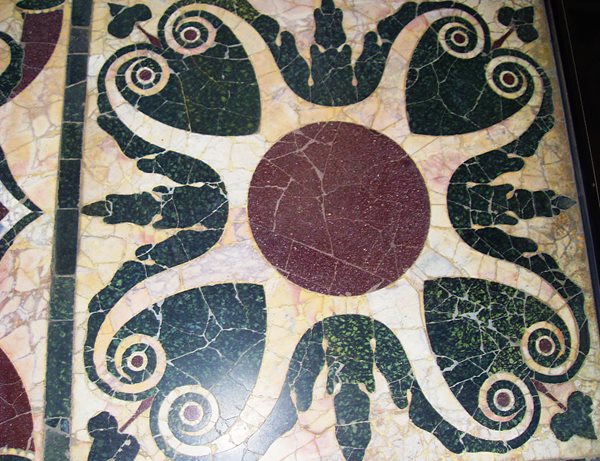11th century
Greek Porphyry from Viking Dublin
Possibly from early medieval pilgrimages to Rome.
By Leo McNameeDescription
These three pieces of green porphyry were found during excavations directed by Breandán Ó Ríordáin (of the National Museum of Ireland) at Christchurch Place and High Street between 1972 and 1976. The original register entries describe them as “cut green stone”, “a piece of shaped and polished marble?” and “polished marble”. These excavations, just south of Christchurch Cathedral, produced evidence of intensive occupation in the area from the mid-tenth century to the late-thirteenth/early-fourteenth centuries. The excavations highlighted that the main period of activity occurred between the mid-tenth and twelfth century; with these fragments of porphyry found in the 11th century layer.
The three pieces were found in different contexts and are not related. The first piece (E122:131) has three highly polished sides with a bevelled edge. There are signs of wear on one edge. The second (E122:14650) is long and narrow and not as thick as the others; two faces are smooth but not polished. The third (E71:16956) is darker in colour with three polished sides. It seems likely that all three pieces are fragments of decorative Roman floor tiles.

What is porphyry?
Porphyry is a hard igneous rock containing crystals of feldspar in a fine-grained groundmass. The word porphyry comes from the Greek porphura meaning purple and is probably of Semitic origin. The porphyry discussed here is dark-green in colour and was quarried in the eastern Mediterranean, most likely Laconia in Greece. Examples of imported red porphyry quarried in Egypt have also been found in Ireland. Porphyry can naturally occur in Ireland as well but it is often greyish in colour.
Porphyry in ancient Rome
The Romans quarried porphyry extensively for use in buildings, columns, pavements, statues, busts and sarcophagi. Green porphyry was being used in the city of Rome by the Augustan period and elsewhere in the empire by the time of Diocletian, who used it in the building of his palace in Split. Red porphyry seems to have been preferred by Roman emperors for imperial busts and sarcophagi, possibly because of its purple colour. Purple dye was greatly prized in ancient Rome as it was difficult to produce (it came from marine snails), was expensive and did not fade.
Trade between medieval Ireland and Europe
Many ecclesiastical documents make reference to trade between Ireland and Europe. The literary evidence for foreign trade is backed up by archaeological evidence; for example, imported Roman artefacts (including coins, lamps and pottery) have been found at Dalkey, Knowth, Lagore, Ballinderry and Carraig Aille to name a few. These items were either imported from post-Roman Britain / Europe or survive from earlier contact. Other imports included tin ore and mercury used in metalworking as well as amber and jet. There was an increase in the use of amber in the decoration of precious objects (such as the Derrynaflan chalice) between the 8th and 10th centuries.
Imported porphyry in early medieval Ireland
Porphyry was also imported to Ireland from post-Roman Europe, most likely as souvenirs or keepsakes taken by Christian pilgrims to Rome. It may also have been imported for use in shrines or tombs or have come to Ireland indirectly from merchants or travellers in Britain, Gaul or Scandinavia. The stone probably came from the floors, mosaics and pavements of recycled Roman imperial buildings. The fact that porphyry fragments are often found in ecclesiastical sites, such as High Island, Co. Galway and Skeam West, Co, Cork, strengthens the argument that they were brought back from pilgrimages. There is also documentary evidence to support this; King Canute reopened the pilgrim route to Rome in 1027 after a period of taxation and harassment of pilgrims. Treaties with the German emperor, Conrad, and the king of Burgundy, Rudolf II, guaranteed the safety of pilgrims and records show that there were 12 pilgrimages to Rome from Ireland in the 11th century. Many of these pilgrims would have travelled through Dublin and several pieces of porphyry were found during the Dublin excavations from this time.
In total, 33 fragments of imported porphyry have been found to date. 20 of these have been found in Dublin and Waterford with the remainder coming from ecclesiastical sites. Most are fragments of green porphyry with only two know pieces of red porphyry. The argument for a Scandinavian trade in recycled porphyry is aided by the finding of so many pieces in port towns. Indeed, a large piece of red porphyry, which is currently on display in the National Museum of Ireland, could have been brought to Ireland with the intention to cut it up into smaller pieces.
Learn More
These fragments of porphyry are part of the museum’s reserve collection and are not currently on display. However, there are some fragments of porphyry from Viking Dublin on display in the National Museum of Ireland’s Viking exhibition.
References
Comber, M. (2001) "Trade and Communication Networks in Early Historic Ireland", The Journal of Irish Archaeology, 10, Wordwell Ltd.
Lynn, C. (1984) "Some Fragments of Exotic Porphyry found in Ireland", The Journal of Irish Archaeology, 2, Wordwell Ltd.
Murray, H. (1983) "Viking and Early Medieval Buildings in Dublin: a study of the buildings excavated under the direction of A. B. Ó Ríordáin in High Street, Winetavern Street and Christchurch Place, Dublin 1962-63, 1967-76", British Archaeological Reports, 119, Oxford.
Scally, G. (2014) "High Island (Ardoileán), Co. Galway: Excavation of an Early Medieval Monastery", Archaeological Monograph Series: 10.
Location:
Greek Porphyry from Viking Dublin is located at:
In Storage
Previous artefact:
Next artefact:
Here Be Dragons! A Wrought Iron Sienese Dragon
